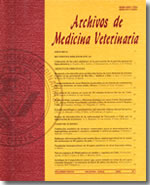Effect of three transport conditions on the appearance time of autolysis in samples of rainbow trout fry (Oncorhynchus mykiss)
Main Article Content
Abstract
The aim of this work was to compare three types of transport conditions on the appearance and progress of autolytic changes in samples of dead fry sent to be processed for histopathological analysis. 300 whole fry corpses were subjected to three transport conditions: submerged in water at 4 °C, submerged in water at 15 °C and dry atmosphere at 4 °C. Every hour from 0 to 24 hours, groups of 4 fry per condition were fixed in 10% formalin and processed using the conventional hematoxylin and eosin stain technique (H&E). The appearance time of the autolytic changes in the different segments of the kidney and liver were determined in each group, classifying the changes as early autolytic, advanced autolytic and complete autolysis. It was observed that the autolytic changes appeared first in the livers of the corpses at 4 °C under dry condition while last ones to be affected were the corpses submerged in water at 4 °C (1 and 6 hours, respectively). The first autolytic changes appeared in the kidneys of the corpses at 4 °C in the dry atmosphere and the last in the corpses submerged in water at 4 °C (3 and 9 hours, respectively). It was concluded that out of the three transport conditions studied, the one preserving for longer the histological and cytological structure of the fish tissue for histological analysis was water preservation at 4 °C, demonstrating the key role of the temperature and atmospheric humidity in the progress of fish autolysis.

